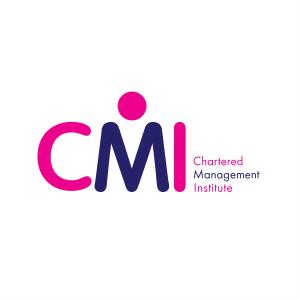

CMI 517 PRINCIPLES OF INNOVATION
• Unit: CMI 517
• Ofqual Reference J/616/3231 • • CMI SYLLABUS | LEVEL 5 PRINCIPLES OF INNOVATION

Aims of the Unit
Innovation has the power to transform organisations, teams and individual performance.
When a culture of innovation and entrepreneurship thrives, new ideas and initiatives flourish.
This unit has been designed to enable learners to identify opportunities for innovation in the workplace (which may be in the form of new working practices, processes, new products or services), analyse the rationale for developing initiatives and know how to turn ideas into reality.

Key Words
Benchmarking, consensus, competitive advantage, market development, producUservice development, innovation, collaboration, intellectual property, feedback, empowering, involvement, creativity.
Understand the role of innovation within organisations
Learning Outcomes
Understand the process of managing innovation in an organisation
Learning Outcome 1: Understand the role of innovation within organisations

LO1 Assessment Criteria
AC 1.1 Examine the reasons for innovation in organisations
AC 1.2 Analyse the types of innovation within organisations
AC 1.3 Evaluate factors that support a culture of innovation in organisations
Best Practice AC 1.1 Examine the reasons for innovation in organisations
Command Verb is Examine - Inspect (something) thoroughly in order to determine its nature or condition.
AC 1.1 Reasons for innovation in organisations:
Reasons may include but are not limited to organisation's growth strategy, competitive advantage (first mover/fast slow followers/market leader),
Best Practice AC 1.1
Examine the reasons for innovation in organisations
AC 1.1 Reasons for innovation in organisations:
• diversification, new/increased sources of revenue, market share, reduced costs,
• improved productivity,
• build brand value, gap in the market,
• respond to trends,
• establish new partnerships/relationships,
• ethical, legal and regulatory changes.
Best Practice
AC 1.2 Analyse the types of innovation within organisations
Command Verb is Analyse - Break the subject or complex situation(s) into separate parts and examine each part in detail; identify the main issues and show how the main ideas are related to practice and why they are important. Reference to current research or theory may support the analysis.
AC 1.2 Types of innovation within organisations:
Best Practice AC 1.2 Analyse the types of innovation within organisations
AC 1.2 Types of innovation within organisations:
• Ideas and innovation
• formal, informal
• continuous improvement
• Organic, incremental, radical
• disruptive, breakthrough
• transitional & transformational
• product, service, & platform

AC 1.2 Types of innovation within organisations:
Best Practice AC
1.2 Analyse the types of innovation within organisations
• exploit new technologies
• business processre-engineering
• business model and processes
• frugal
• open source
• user led/co-creation
• democratic
Best Practice AC 1.3.
Evaluate factors that support a culture of innovation in organisations
Command Verb is Evaluate - Consider the strengths and weaknesses, arguments for and against and/or similarities and differences. The writer should then judge the evidence from the different perspectives and make a valid conclusion or reasoned judgement. Apply current research or theories to support the evaluation when applicable.
AC 1.3. Factors that support a culture of innovation in organisations: Impact of programme and projects: -Vision and leadership styles - Strategic priorities

Best Practice AC 1.3. Evaluate factors that support a culture
of innovation in organisations
AC 1.3. Factors that support a culture of innovation in organisations:
- organisational structure,
- working styles,
- attitude to risk
- resources,
- staff involvement and buy-in.
Learning Outcome 2:
Understand the process of managing innovation in an organisation

LO2 Assessment Criteria
AC 2.1.Evaluate methods used to drive innovation in an organisation
AC 2.2.Examine the process for innovation in an organisation
AC 2.3.Discuss the role of the manager in leading innovation in an organisation
AC 2.4Analyse the role of stakeholders in the innovation process management in an organisational context

Best Practice AC 2.1 Evaluate methods used to drive innovation in an organisation
Command Verb
is Evaluate
- Consider the strengths and weaknesses, arguments for and against and/or similarities and differences. The writer should then judge the evidence from the different perspectives and make a valid conclusion or reasoned judgement. Apply current research or theories to support the evaluation when applicable.
AC 2.1 Methods used to drive innovation in an organisation

Best Practice AC 2.1 Evaluate methods used to drive innovation in an organisation
AC 2.1 Methods used to drive innovation in an organisation
• brainstorming,
• quality circles
• mind mapping
• customer feedback
• customer and market research
• focus groups, co-creation,
• sharing prototypes (e.g. products to address unmet needs},

Best Practice AC 2.1 Evaluate methods used to drive innovation in an organisation
AC 2.1 Methods used to drive innovation in an organisation
• data interrogation and analysis
• emulate competitors
• supplier/partner involvement
• formal suggestion or incentive schemes, restructuring
• Kirton's Adaptation-Innovation (KAI) Theory, (2003).
Best Practice AC 2.2.Examine the process for innovation in an organisation
Command Verb is Examine- Inspect (something) thoroughly in order to determine its nature or condition.
AC 2.2 Process for innovation in an organisation.
• research,
• design,
• development of business case (including objectives, success criteria and key performance indicators, cost benefit, analysis/investment appraisal, timescales),

Best Practice AC 2.2.Examine the process for innovation in an organisation
Command Verb is Examine- Inspect (something) thoroughly in order to determine its nature or condition.
AC 2.2 Process for innovation in an organisation.
• research,
• design,
• development of business case (including objectives, success criteria and key performance indicators, cost benefit, analysis/investment appraisal, timescales),
AC 2.2 Process for innovation in an organisation.
• scope,
Best Practice AC
2.2.Examine the process for innovation in an organisation
• approvals,
• develop,
• pilot/test,
• implement,
• feedback and monitoring,
• communicate,
• stakeholder engagement,
• review and evaluate.

Best Practice
AC 2.3.Discuss the role of the manager in leading innovation in an organisation
Command Verb is Discuss - Give a detailed account including a range of views or opinions, which include contrasting perspectives..
AC 2.3. Role of the manager in leading innovation in an organisation research,
• championing ideas,
• gaining stakeholder buy-in and commitment,
• managing stakeholders,
• securing resources, research and investigation, establishing processes and procedures, communication, supporting and implementing good practice, monitoring and measuring impact.
Best
Practice AC 2.3.Discuss the role of the manager in leading innovation in an organisation
AC 2.3. Role of the manager in leading innovation in an organisation research,
• securing resources,
• research and investigation,
• establishing processes and procedures,
• communication,
• supporting and implementing good practice,
• monitoring and measuring impact.

Best Practice AC 2.4. Analyse the role of stakeholders in the innovation process
Command Verb is Discuss - Break the subject or complex situation(s) into separate parts and examine each part in detail; identify the main issues and show how the main ideas are related to practice and why they are important. Reference to current research or theory may support the analysis..
AC. 2.4.Analyse the role of stakeholders in the innovation process
• ideas,
• decision making,
Best Practice AC 2.4. Analyse the role of stakeholders in the innovation process
AC. 2.4.Role of stakeholders in the innovation
• approval,
process
• consultation,
• testing and feedback,
• specialist advice and support,
• Responsible, Accountable, Consulted, Informed (RACI).

Best Practice AC 2.5. Evaluate methods used to measure the impact of innovation in an organisation
Command Verb is Evaluate - Consider the strengths and weaknesses, arguments for and against and/or similarities and differences. The writer should then judge the evidence from the different perspectives and make a valid conclusion or reasoned judgement. Apply current research or theories to support the evaluation when applicable.
AC. 2.5.Methods used to measure the impact of innovation in an organisation ideas,
• development of key performance indicators, financial measures (e.g. revenue, profit, cost reduction), customer acquisition, loyalty and retention, market share and reach, compliance, quality audits, feedback, ratings and reviews.
AC. 2.5.Methods used to measure the impact of innovation in an organisation
Best Practice AC
2.5. Evaluate methods used to measure the impact of innovation in an organisation
• development of key performance indicators,
• financial measures (e.g. revenue, profit, cost reduction),
• customer acquisition,
• loyalty and retention,
• market share and reach,
• compliance, quality audits,
• feedback, ratings and reviews.
Suggested reading/web resource materials for CMI 604
Textbooks/eBooks
•Johnson, Whittington and Scholes, 2012, Exploring Corporate Strategy
Relevant Theories, Frameworks and Models
•Adaptation-Innovation (KAI) Theory (Kirton, 2003)
•RACI Matrix (Responsible, Accountable, Consulted, Informed)

Growth Strategy in Innovation
• Innovation plays a pivotal role in driving organizational growth by enabling firms to expand their market presence, attract new customers, and create a competitive edge.
• A growth strategy fueled by innovation involves not only the development of new products or services but also transforming existing business models and processes.
• Innovation-led growth can be categorized as either organic growth or growth through acquisitions and partnerships, each approach offering unique pathways for expanding an organization’s market reach and operational capabilities.
Growth Strategy in Innovation
1. Organic Growth through Innovation
Product Innovation
Introducing novel products or enhancing existing ones allows organizations to attract customers by fulfilling unmet needs.
-For example, tech companies consistently release upgraded products with added features, which can increase customer satisfaction and loyalty.
Service Innovation
Organizations also achieve growth by refining services, offering new customer experiences, and tailoring services to niche markets.
In the hospitality industry, for instance, providing personalized services, such as unique check-in experiences or curated travel plans, can draw new clientele and deepen market reach.

Growth Strategy in Innovation
1. Organic Growth through Innovation
Process Innovation
Optimizing internal processes to reduce costs and improve efficiency indirectly supports growth.
Process innovations like Lean or Agile methodologies in manufacturing and software development can significantly enhance productivity, making it possible for companies to reinvest savings into growth initiatives.
Growth Strategy in Innovation
2. Growth through Mergers, Acquisitions, and Partnerships
Strategic Acquisitions
Acquiring companies with unique technologies, expertise, or market positioning is a common growth strategy.
For instance, Google’s acquisition of YouTube enabled it to expand into online video streaming, a rapidly growing segment.
Joint Ventures and Alliances
Partnering with complementary organizations can accelerate growth by combining resources and expanding market reach.
-An example is the partnership between Starbucks and PepsiCo to distribute Starbucks ready-to-drink coffee beverages, opening Starbucks to new markets through PepsiCo’s distribution networks.
Growth Strategy in Innovation

2. Growth through Mergers, Acquisitions, and Partnerships
Technology Integration
Acquisitions that bring in new technology, such as artificial intelligence or data analytics, can allow companies to develop innovative solutions and tap into modernized, more efficient operations. These integrations lead to long-term growth potential by improving product offerings and operational efficiency.

Growth Strategy in Innovation

3. Market Expansion through Innovation
Geographical Expansion
Entering new geographical markets can be supported by innovative products adapted to regional tastes or needs.
Companies like McDonald’s often innovate their menus to suit local preferences when expanding internationally.
Targeting New Customer Segments
Innovation also involves developing offerings for previously untapped customer segments.
Electric car companies, for instance, are now innovating to reach new customer bases by creating more affordable, compact electric vehicles targeting urban drivers.

Growth Strategy in Innovation
Growth strategies innovation and long-term benefits:
✓ Enhanced Brand Value
Consistent innovation reinforces a company’s brand, making it synonymous with quality and forward-thinking.
✓ Increased Market Share
Through first-mover advantages, improved products, or new customer bases, innovative companies can capture and maintain a substantial market presence.
✓ Sustainable Revenue Streams
Innovative companies often succeed in generating diverse revenue channels, which stabilize income even as markets change.


Competitive Advantage Through Innovation
• Innovation is a key driver in gaining and sustaining a competitive advantage.
• Organizations use innovation to differentiate themselves, capture market share, improve their offerings, and establish brand loyalty.
• The types of competitive advantages linked to innovation can vary, but three primary approaches are:
• First-Mover Advantage
• Fast-Follower Strategy, and
• Market Leadership Position.

Competitive Advantage Through Innovation
1. First-Mover Advantage (Innovation as Industry Leader)
• Refers to the competitive edge gained by a company that introduces a new product, service, or technology before others.
• By being the first to innovate, these companies can establish strong brand recognition, capture initial market share, and set the standard for the industry.

Competitive Advantage Through Innovation
Benefits of First-Mover Advantage
-Pioneering companies often secure a dominant position in the market before competitors arrive.
-Early adopters tend to develop brand loyalty that lasts even as competitors enter the market.
-Being the first to innovate gives firms the opportunity to set technical standards, creating barriers for competitors.
-A first-mover can create such strong barriers to entry that potential competitors might hesitate to enter the market.

Competitive Advantage Through Innovation
2. Fast-Follower Strategy (Innovation with Reduced Risk)
-Refers to companies that wait for the first-mover to test the waters and then rapidly adopt and improve upon the initial innovation.
-These companies avoid the initial risk of being the first to market but still benefit from a successful product or technology.

Competitive Advantage Through Innovation
Benefits of Fast-Follower Strategy (Innovation with Reduced Risk)
-By observing the first mover, companies can understand market reactions, customer feedback, and technical issues that arise, thus avoiding the early pitfalls.
-Fast followers often improve upon the original innovation, making their version more efficient, user-friendly, or cost-effective.
-Developing a similar product after market introduction typically allows a fast follower to reduce costs associated with research and development.
-Fast followers can achieve rapid market entry, capitalizing on the established demand.

Competitive Advantage Through Innovation
3. Market Leader Position (Sustaining Innovation for Leadership)
-Innovation helps an organization maintain its Market Leader Position by continuously improving its products, processes, and services.
-Market leaders are companies that not only innovate but also set industry standards, influence market trends, and drive future developments.

Competitive Advantage Through Innovation
Benefits of Market Leader Position (Sustaining Innovation for Leadership)
-As market leaders, innovative companies set the industry standard and often influence trends, consumer behavior, and even regulatory frameworks.
-Continual innovation reinforces the brand's authority in the industry, making the company synonymous with excellence and reliability.
-Regular innovation helps a company defend against challengers by constantly upgrading its offerings, reducing the chance of being overtaken.
-Market leaders use innovation to respond to changing customer needs, ensuring that they remain the preferred choice.
Diversification (Innovation to Expand and Mitigate Risk)
Competitive Advantage Through Innovation
-Allows companies to expand into new sectors, technologies, or products, spreading risk across multiple areas rather than depending on a single market.
-Approach creates opportunities for new revenue sources and positions the organization to better withstand market shifts.
-Often pursued by companies in saturated markets, allowing them to capture new customer segments, penetrate untapped industries, or explore new technological advancements.

Competitive Advantage Through Innovation
Diversification (Innovation to Expand and Mitigate Risk)
Types of Diversification
• Related Diversification: Expanding into areas that are directly related to existing products or services. For example, a technology company might move into new tech fields such as artificial intelligence (AI) in healthcare.
• Unrelated Diversification: Entering industries or markets that are distinct from the company’s existing offerings, thereby expanding the business portfolio.
Competitive Advantage Through
Innovation Revenue Streams (Generating New Sources of Income Through Innovation)
-Innovation opens up opportunities for new revenue channels by meeting unmet customer needs or capitalizing on emerging market trends.
-A common example in technology and software is the shift from traditional product sales to subscription models, which provides ongoing revenue and customer retention.
-By introducing new ways to monetize products, services, or data, organizations create resilience against market changes and establish long-term revenue growth.
Competitive Advantage Through Innovation
Types of Revenue Streams from Innovation
Subscription Models-Allow for a continuous revenue stream, as seen in the software industry, where companies now offer services on a subscription basis rather than as one-time purchases.
Data Monetization- Organizations may leverage customer data to develop analytics products or offer insights as a service to other businesses.
Product as a Service (PaaS)-Instead of selling products outright, some companies lease or provide them as a service, which includes regular maintenance and updates.
Competitive Advantage Through Innovation
Market Share Expansion (Increasing Market Presence Through Innovation)
-Companies that continually innovate are often able to capture larger shares of the market by attracting new customers and retaining existing ones through new features, improved technology, or enhanced product experiences.
-This not only drives growth but also secures the company’s position as a leader in the market.
-Market share expansion through innovation requires a customer-centric approach, focusing on evolving needs and trends.

Competitive Advantage Through Innovation
Ways to Expand Market Share through Innovation
Incremental Innovation- Introducing small but valuable updates to existing products.
Disruptive Innovation- Creating new products or services that address gaps in the market or disrupt the current market norms, attracting a new segment of customers.
Product Line Extension- Expanding existing products to cover a wider range of customer needs or preferences. This can include introducing different versions, such as entry-level or premium products.

Competitive Advantage Through Innovation
Cost Reduction and Productivity
-Process innovations, such as the adoption of new technologies or the implementation of efficiency-focused methodologies, play a vital role in reducing operational costs.
-These innovations streamline workflows, reduce waste, and allow businesses to achieve higher productivity, which directly impacts profitability.
-Common examples include automation technologies that replace repetitive manual tasks and Lean Six Sigma practices, which focus on eliminating inefficiencies and enhancing quality.

Competitive Advantage Through Innovation
Cost Reduction and Productivity- Key Elements
• Automation-Technologies like robotics and AI streamline repetitive tasks, saving time and labor costs.
• Lean Six Sigma: A data-driven approach that aims to improve processes by reducing waste and variation, increasing overall efficiency.
Example-Toyota uses Lean methodologies to optimize production, reduce waste, and maintain quality, exemplifying cost reduction through innovation.

Competitive Advantage Through Innovation
Brand Value and Reputation
• Consistent innovation helps build strong brand value by associating a brand with forward-thinking, quality products.
• Companies that prioritize innovation foster loyalty, as customers view them as leaders in their industry.
• This is particularly true for companies like Tesla, which is associated with electric vehicle innovation, and Apple, known for its cutting-edge technology and design.
• Over time, a reputation for innovation strengthens brand equity, making customers more likely to choose and recommend the brand.

Competitive Advantage Through Innovation
Brand Value and Reputation-Key Elements
• Innovative brands build strong emotional connections with consumers, leading to customer retention.
• Innovation reinforces a brand's core identity, making it memorable and recognizable in the market.
Example -Apple: Known for its focus on aesthetics, functionality, and technology, Apple has built a brand identity associated with high quality and innovation.

Competitive Advantage Through Innovation
Market Gap Identification
• Innovation often involves identifying and addressing gaps in the market where customer needs are unmet.
• By providing unique solutions to these gaps, companies can create entirely new categories or markets.
• Approach allows organizations to achieve rapid growth and set the standard in emerging markets.
Uber, for example, transformed urban transportation by addressing inefficiencies in traditional taxi services, resulting in a significant market share.

Competitive Advantage Through Innovation
Key Elements -Market Gap Identification
Unmet Needs
-Innovation targets specific needs or inefficiencies in existing products or services.
First-Mover Advantage
Identifying and fulfilling a market gap early can position a company as a market leader.

Competitive Advantage Through Innovation
Response to Trends
-Innovation aligned with societal, technological, and environmental trends allows companies to stay relevant and responsive to consumer expectations.
-With increasing awareness of environmental sustainability, many companies have invested in eco-friendly innovations, like biodegradable packaging or renewable energy sources.
-This responsiveness enhances brand loyalty and aligns the business with global shifts in consumer preferences.

Competitive Advantage Through Innovation
Response to Trends
Societal Trends- Innovation that caters to evolving cultural and lifestyle shifts.
Environmental Sustainability- As consumers prioritize sustainable practices, eco-innovation becomes essential in maintaining market presence.
Example-Unilever: Responded to the growing demand for sustainable products by launching eco-friendly product lines and sustainable sourcing initiatives.

Competitive Advantage Through Innovation
Ethical, Legal, and Regulatory Changes
-Organizations need to adapt products or processes in response to regulatory and ethical standards, especially as these standards evolve.
-Compliance innovation is crucial in industries such as food and healthcare, where ethical sourcing, health standards, and environmental considerations are prioritized.
-Adaptations not only help meet legal requirements but also build trust among consumers who value ethical and compliant brands.
Competitive Advantage Through Innovation
Ethical, Legal, and Regulatory Changes- Key Elements
Compliance
Innovations may focus on meeting legal standards while maintaining profitability.
Corporate Social Responsibility (CSR)
Emphasizes ethical behavior in sourcing, production, and product innovation.
Example: Nestlé adapted to new environmental regulations by reducing plastic in its packaging and pursuing biodegradable alternatives.

Competitive Advantage Through Innovation
Establishing New Partnerships and Relationships
-Innovation often requires collaborative efforts, especially in complex fields like technology or healthcare.
-Forming partnerships allows companies to leverage shared resources, expertise, and market access.
-This approach can also foster co-innovation, where two companies develop a solution that neither could achieve independently.
For example, collaborations between tech companies and medical institutions have accelerated advancements in healthcare technology.
Competitive Advantage Through Innovation
Establishing New Partnerships and Relationships
Resource Sharing
Partnerships allow companies to access new markets, technology, and expertise.
Market Access
Collaboration can facilitate entry into new markets or regions through combined strengths.
Example-IBM and Apple collaborated to create business applications that utilize IBM’s data analytics expertise and Apple’s design and user interface expertise.

Types of Innovation within Organisations
Ideas vs Innovation
Ideas represent the raw thoughts, initial concepts, or inspirations that have potential but are not yet practically applicable or value-generating on their own.
-They are starting points that need refinement, structure, and direction to make a tangible impact.
-Innovation, however, is the process of converting these ideas into practical, actionable, and marketable solutions that add real value to an organization or society.
-Innovation transforms ideas into products, services, or processes that can be implemented to solve problems or meet needs.
Example:
An idea might be to reduce environmental impact, while innovation is creating biodegradable packaging that fulfills this vision.
Types of Innovation within Organisations
Formal vs. Informal Innovation
Formal Innovation- Involves structured processes, often within research and development (R&D) departments, with dedicated resources and defined goals.
Informal Innovation- Arises spontaneously within the organization, often driven by employee initiative without formal support.
Example: Google’s “20% time” policy allows employees to work on side projects, leading to informal innovation that has produced products like Gmail.
Continuous Improvement
Types of Innovation within Organisations
-Small, ongoing changes that gradually improve processes, quality, and efficiency within an organization.
-Often involves methodologies like Kaizen.
Example
Manufacturing companies regularly refine production processes to reduce waste, improving efficiency and lowering costs.

Types of Innovation within Organisations
Organic Innovation
Innovation that develops naturally within an organization, typically in response to internal insights or spontaneous initiatives.
Example
-An IT team might organically develop a software tool to streamline internal processes, later scaling it as a product.

Types of Innovation within Organisations
Incremental Innovation
-Small adjustments to existing products, services, or processes that add value without disrupting current markets.
Example-The regular updates to smartphone features represent incremental innovation, improving the product without drastic changes.
Radical Innovation
-Creates entirely new products or processes that can redefine industries or markets.
Example-Electric cars represent a radical innovation in the automotive industry, transforming market expectations and regulatory standards.

Types of Innovation within Organisations
Disruptive Innovation
-Innovations that initially cater to niche markets or underserved segments but eventually overtake established products and disrupt the industry.
Example- Netflix’s streaming model disrupted traditional video rental and later, broadcast television.
Breakthrough Innovation
-High-risk innovations that lead to groundbreaking advancements, often involving new technologies.
Example- The development of CRISPR gene-editing technology is a breakthrough innovation in biotechnology.

Types of Innovation within Organisations
Transitional and Transformational Innovation
Transitional
-Innovations that help an organization move from one stage to another, such as adopting digital tools to move from paper-based to digital records.
Transformational
-Innovations that alter the core aspects of the business, leading to a fundamental change in operations or customer engagement.
Example: Moving from physical retail to an e-commerce model is transformational.

Types of Innovation within Organisations
Product, Service, Platform, and Experience Innovation
• Product Innovation- Introducing a new or improved product to the market.
• Service Innovation: Enhancing customer experience or adding new service layers, like online support or loyalty programs.
• Platform Innovation: Creating a platform that connects multiple users or services, as seen with social media networks or app ecosystems.
• Experience Innovation: Innovating around customer engagement, creating memorable experiences that enhance brand loyalty.
Ex: Apple combines product (iPhone), platform (App Store), and experience innovations for a comprehensive brand strategy.
Types of Innovation within Organisations
Exploit New Technologies
-Leveraging emerging technologies enables organizations to develop new products, improve existing services, or enhance internal processes.
-Important in rapidly evolving industries where adopting the latest technology can mean staying competitive.
-By integrating new technologies, businesses can scale, improve efficiency, and enter new markets.
Ex: Cloud computing is a prime example. With cloud technology, companies can host applications, store data, and scale services on demand without heavy infrastructure investments.
This technology has allowed startups and large enterprises alike to innovate quickly and focus resources on growth rather than infrastructure.
Types of Innovation within Organisations
Business Process Re-Engineering (BPR)
-BPR is the radical redesign of core business processes to achieve dramatic improvements in productivity, efficiency, and quality.
-Involves fundamentally rethinking workflows, often supported by new technology, to streamline operations, reduce costs, and enhance the speed and accuracy of processes.
-Focuses on reimagining processes rather than incrementally improving them.
-Robotic Process Automation (RPA) in data entry is a powerful example. By automating repetitive data tasks, companies reduce the need for manual labor, minimize errors, and free up employee time for higher-value activities. This shift can lead to transformative productivity gains.
Types of Innovation within Organisations
Frugal Innovation
-Focuses on creating affordable solutions that meet essential needs, often in resource-constrained markets.
-This approach emphasizes simplicity, cost-effectiveness, and practicality, enabling companies to reach underserved customer segments or operate efficiently in environments with limited resources.
-Relevant in healthcare, education, and environmental sustainability, where affordability and accessibility are key.
Ex: In regions with limited access to healthcare, developing low-cost medical devices like portable ECG machines allows healthcare providers to offer essential services without the need for high-end, costly equipment.
Frugal innovation meets basic needs effectively without sacrificing quality.
Types of Innovation within Organisations
Open Source and User-Led/Co-Creation Innovation
Open Source Innovation:
-Characterized by collaborative development where the source materials (e.g., software code) are freely available for anyone to use, modify, and enhance.
-Encourages diverse input, leading to rapid development and continuous improvement.
-Foster innovation through transparency and shared knowledge, as contributors worldwide bring in unique insights and skills.
Ex: Linux is a prime example of open-source software. It’s freely available for anyone to modify and distribute, leading to a robust operating system continually improved by its community.

Types of Innovation within Organisations
User-Led/Co-Creation Innovation
-Involves directly involving customers or end-users in the innovation process.
-By engaging users, companies gain first-hand insight into their needs and preferences, resulting in products that better meet real-world demands.
-Co-creation also builds customer loyalty and creates products with strong market alignment.
Ex: LEGO Ideas platform is a user-led innovation strategy where fans can submit their own designs for LEGO sets. If a design gains enough votes from the community, LEGO may produce it as an official product, showcasing the potential of user collaboration.
Types of Innovation within Organisations
Business Process Re-Engineering (BPR)
-BPR is the radical redesign of core business processes to achieve dramatic improvements in productivity, efficiency, and quality.
-Involves fundamentally rethinking workflows, often supported by new technology, to streamline operations, reduce costs, and enhance the speed and accuracy of processes.
-Focuses on reimagining processes rather than incrementally improving them.
-Robotic Process Automation (RPA) in data entry is a powerful example. By automating repetitive data tasks, companies reduce the need for manual labor, minimize errors, and free up employee time for higher-value activities. This shift can lead to transformative productivity gains.

Types of Innovation within Organisations
Democratic Innovation
-Democratic innovation is an approach where companies encourage ideas from a broad audience—typically employees, customers, or the general public—through a process known as crowdsourcing.
- Empowers a wide range of participants to contribute ideas and feedback, making innovation an inclusive process.
-Inviting individuals at different levels, businesses can tap into diverse perspectives, uncovering new opportunities and trends that may not surface through traditional R&D alone.
Democratic innovation allows for:
-Diverse Idea Generation:
-Increased Customer Engagement
-Enhanced Product-Market Fit
-Faster and Cost-Effective Innovation

Key Drivers of an Innovative Culture in Organizations
Vision and Leadership Styles
-Foundational to fostering innovation.
-Leaders who prioritize innovation communicate a clear vision that encourages exploration and adaptation.
-Leadership styles like transformational leadership, which focuses on inspiring and motivating employees, can significantly enhance innovation by making it part of the organization’s strategic goals.
Ex: Companies like Tesla and Google have leaders who advocate for ambitious, forward-looking goals, which promotes an innovative culture.
Key Drivers of an Innovative Culture in Organizations
Strategic Priorities
-When innovation is embedded as a strategic priority, resources and initiatives are aligned to support it.
-Strategic prioritization of innovation could include setting measurable goals for new product development or investing in R&D.
Ex: A strategic focus on innovation helped Amazon diversify its services, from online retail to cloud computing.
Key Drivers of an Innovative Culture in Organizations

Organisational Structure
-The structure of an organization influences its ability to innovate.
-Flat structures often promote quicker decisionmaking and foster open communication, which encourages idea sharing and collaboration.
-Hierarchical structures may slow innovation due to rigid decision-making processes.
Ex: Startups usually operate with flatter structures, encouraging all employees to contribute ideas, unlike traditional hierarchical corporations.
Key Drivers of an Innovative Culture in Organizations
Working Styles

-Flexible and collaborative working styles, such as cross-functional teams and remote work options, facilitate a culture of innovation.
-Agile working environments support iterative testing and adaptability.
Ex:Tech companies like Atlassian use cross-functional teams that bring together diverse perspectives, fostering innovation.
Key Drivers of an Innovative Culture in Organizations
Attitude to Risk
-Innovation requires an organizational culture that is open to risk-taking and accepts that failure is part of the innovation process.
-Organizations with a high tolerance for calculated risk are better positioned to pursue breakthrough innovations.
Ex: Amazon’s willingness to experiment led to the creation of successful products like Kindle, alongside other products that did not succeed.
Key Drivers of an Innovative Culture in Organizations Resources
-Sufficient allocation of resources, including financial, technological, and human resources, is crucial for sustained innovation.
-Investment in training, tools, and technologies equips employees to contribute to innovation effectively.
-Large corporations such as IBM dedicate substantial budgets to R&D to maintain a competitive edge.
Key Drivers of an Innovative Culture in Organizations
Staff Involvement and Buy-In
-Employees’ active engagement and commitment to innovation initiatives are vital.
-Involving staff in decision-making and innovation activities fosters ownership, motivation, and creativity. -Companies like 3M encourage employees to spend time on independent projects, promoting buy-in and involvement in innovative solutions.


Methods for Driving Innovation
Brainstorming
-Encourage team members to share a range of ideas without judgment.
-Open, collaborative method fosters creativity and often leads to innovative solutions that may not have surfaced otherwise.
-Many tech companies use brainstorming to develop new app features, where all suggestions are encouraged to generate a wide pool of ideas.
Quality Circles
Methods for Driving Innovation
-Involve small groups of employees who meet regularly to identify and solve work-related issues.
-Groups encourage participation and can improve both product and process innovation.
-In manufacturing, quality circles may be used to suggest process improvements that increase efficiency and product quality.

Methods for Driving Innovation
Mind Mapping
-Organizes ideas visually, showing relationships between concepts.
-Helps teams identify connections that lead to innovative solutions and see how different ideas fit into the broader vision.
-Product development teams may use mind maps to explore various features for a new product.
Methods for Driving Innovation
Customer Feedback
-Gathering customer feedback enables organizations to understand unmet needs and areas for improvement.
-Helps tailor innovation to directly address customer pain points, making products more successful.
-SaaS companies regularly collect feedback to improve their software features based on user preferences and requests.
Customer and Market Research
Methods for Driving Innovation
-Conducting customer and market research allows organizations to stay informed about market trends and customer expectations, positioning them to innovate effectively.
-A company may use market research to explore trends in eco-friendly products, then innovate to meet the demand for sustainability.
Methods for Driving Innovation
Focus Groups
-Bring together small groups of customers or users to gather insights on potential products or services.
-Allow organizations to test ideas with real users, guiding innovations that resonate with target markets.
-Ex: Automobile companies often use focus groups to assess new vehicle features or designs.

Methods for Driving Innovation
Co-Creation
Involves partnering with customers or other stakeholders in the innovation process.
-Collaborative approach generates ideas that are more aligned with user needs.
-Ex: LEGO engages customers to submit ideas for new products, some of which are then developed as official LEGO sets.

Methods for Driving Innovation
Sharing Prototypes
-Enables companies to test early versions of products with users, gaining insights that help refine and improve innovations before a full launch.
Tech companies frequently release beta versions of software to gather user feedback.
Data Interrogation and Analysis
Methods for Driving Innovation
-Used to interpret customer behavior, market trends, and internal processes.
-Evidence-based approach supports innovations that are grounded in real data.
-Ex-Analyzing purchase data may reveal high-demand features, guiding new product development.
Methods for Driving Innovation
Emulate Competitors
-Observing competitors can reveal opportunities to innovate by building on successful features or improving areas where competitors fall short.
-Ex: Smartphone companies may emulate and improve upon popular features launched by rivals to stay competitive.
Supplier/Partner Involvement
Methods for Driving Innovation
-Involving suppliers or partners in the innovation process can enhance resources and expertise, enabling more complex or effective innovations.
-Many tech companies work with suppliers to develop unique hardware components.
Methods for Driving Innovation
Formal Suggestion or Incentive Schemes
-Encourage employees to contribute innovative ideas, fostering an inclusive culture of innovation.
Ex: 3M’s “15% rule” gives employees time to pursue innovative ideas, which led to the development of the Post-it Note.
Restructuring
Methods for Driving Innovation
-Restructuring teams or workflows may create an environment more conducive to innovation by removing barriers and encouraging fresh perspectives.
-Example: A company might adopt agile workflows, restructuring teams to improve responsiveness and innovation.

Methods for Driving Innovation
Mind Mapping
-Organizes ideas visually, showing relationships between concepts.
-Helps teams identify connections that lead to innovative solutions and see how different ideas fit into the broader vision.
-Product development teams may use mind maps to explore various features for a new product.
Methods for Driving Innovation
Kirton's Adaptation-Innovation (KAI) Theory
Kirton’s Adaptation-Innovation (KAI) Theory, developed by cognitive psychologist Michael Kirton, outlines a framework for understanding individual differences in cognitive style, particularly in the way people approach problem-solving and creativity. This theory is widely used in organizational contexts to optimize teamwork, foster innovation, and enhance change management.

Methods for Driving Innovation
Key Concepts of KAI Theory
Kirton proposed that individuals lie on a continuum between high adaptation and high innovation. Both ends of this continuum represent different forms of creativity:
• Adaptors tend to focus on solving problems within existing structures and systems.
• Innovators prefer to challenge norms and explore unconventional or untested solutions.

Methods for Driving Innovation
Cognitive Styles in Problem-Solving
-Adaptors seek to do things better, refining established processes and structures. They excel at enhancing stability, continuity, and incremental progress.
-Innovators strive to do things differently, breaking away from traditional methods to foster change and innovation. They thrive in dynamic, uncertain environments and prefer visionary roles.
Individual Style Development
Each person’s cognitive style is shaped by a combination of innate traits and life experiences.
KAI theory emphasizes that understanding these cognitive styles within an organization can strengthen its ability to embrace change and manage diversity effectively.
Methods for Driving Innovation
Adaptors and Innovators: Key Traits
Adaptors:
• Prefer established systems and structures.
• Tend to approach problems with discipline, preferring solutions that have been tested or refined.
• Are agents of stability and progress.
• Often found in managerial or operational roles, focusing on maintaining efficiency and improving existing methods.
Innovators:
• Dislike constraints, preferring to work outside traditional methods.
• Approach problems creatively, often challenging the problem as presented.
• Thrive in roles that drive change and react to new challenges.
• Commonly found in strategic or visionary positions, where unconventional thinking is valued.
Methods for Driving Innovation
The KAI Continuum
The KAI continuum positions individuals based on their preference for adaptation or innovation.
A graphical representation of the continuum can help visualize how people range from high adaptors to high innovators, with most people falling somewhere in the middle.

Methods for Driving Innovation
The Role of Bridges in Organizations
Kirton introduced the concept of a "bridge" — an individual who connects the strengths of both adaptors and innovators within a team:
Bridges facilitate collaboration and mitigate conflicts by encouraging mutual understanding between differing cognitive styles.
They often hold an intermediate position on the continuum, allowing them to appreciate both perspectives and mediate effectively.
Methods for Driving Innovation
Organizational Implications of KAI Theory
KAI Theory provides a framework for understanding and leveraging diverse cognitive styles within an organization:
-High-performing teams benefit from a mix of adaptors and innovators. Adaptors can focus on refining and improving existing systems, while innovators drive exploration and transformational change.
-Placing individuals in roles that match their cognitive style can maximize productivity and job satisfaction.
-Recognizing different problem-solving styles helps reduce misunderstandings and conflicts. Leaders can assign bridge roles to facilitate teamwork and enhance collaborative creativity.
-By appreciating both styles, organizations can create a culture that values stability and incremental improvement, alongside risk-taking and innovation.
RACI Matrix
The RACI Matrix helps clarify roles in innovation projects by defining who is Responsible, Accountable, Consulted, and Informed. This clarity promotes structured innovation and reduces delays.
The RACI Matrix is a grid system which splits individual, team and cross-functional tasks and responsibilities into four participatory types. These are then assigned to different roles in the project or process. The acronym RACI is derived from the responsibility types.
• RACI represents:
• R - Responsible
• A - Accountable
• C - Consulted
• I - Informed
These roles are explained on the right, and below this you will find an example of a RACI matrix.

RACI Matrix
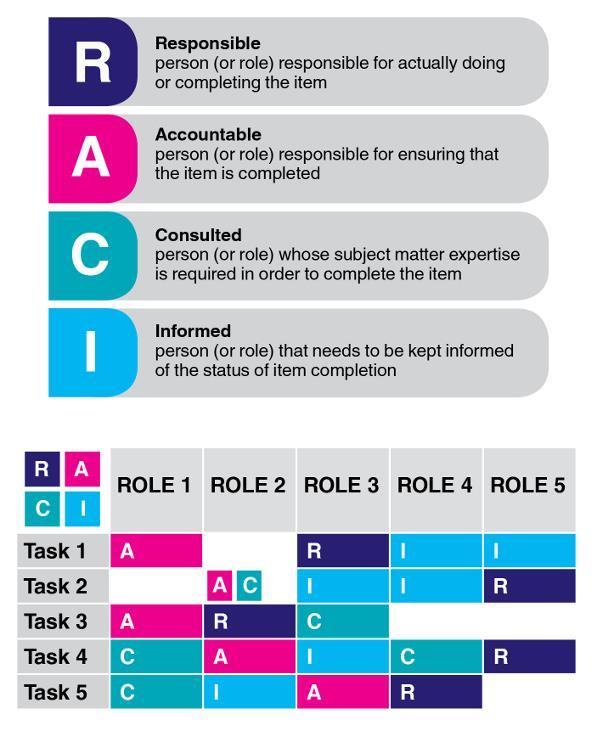

Design and Conceptualization
To convert research insights into actionable concepts that can form the foundation of an innovative product, service, or process. This stage ensures ideas are practical, aligning them with both user needs and organizational objectives.
Activities Involved:
• Creating Prototypes: Developing early models or representations of the concept. Prototypes range from low-fidelity sketches to interactive digital models, depending on complexity.
• Visualizing the Product/Service: Using visuals such as storyboards, mockups, and diagrams to define how the product or service will look, function, and integrate into the user’s life.
• Defining the Initial Concept: Outlining the scope, target audience, key features, and unique selling points of the innovation.

Project Objectives
• Scope and scale provide the parameters of the project
• Within parameters, time & cost minimised
• Quality maximised, not compromised
• In summary, performance & quality, budget, time to completion (Lock)
Project Scope
Identifies its work content and its products or outcomes.
A boundary setting exercise which attempts to define the dividing line between what each part of the project will do and what it wont do.
Clarifies the responsibilities of all who are involved in the project.

Project Scope
Important for managing contractors because of the commercial and legal aspects of an outside contractors relationship with the organisation which is managing the project
A contractors ‘scope of supply’ will identify the boundaries within which the work must be done.

Defining the Scope Example
• The parts of the organisation which are affectedfor example ‘designing and installing an automated guided vehicle system in a warehouse up to the receiving bay’.
• The time involved- foe example ‘installation to begin no earlier that 15Jan and to be completed no later that 2 March
Defining the Scope Example

• The business processes involved; for example , to interface with the current order retrieval system and stock location system’
• The resources to be used, for example ‘to provide own power supply and limit the number of staff working on the installation to five at any one time
• The contractors responsibilities, for example,’ to include all ancillary power and information supply systems, full maintenance schedules and initial training
Project Scope & Scale - Details
• Technical
• Geographical
• Financial
• Legal/standards
• Timescales
• ‘Sign-off’ payments
• Quality
• Penalties
• Deliverables
• Ancillary services e.g. training, translation, warranties, manuals, drawings, after-sales support etc.
• Reporting
• Project Team
Project Scope & Scale

• May be simple/small or complex/large
• Form the contractual obligations which the contractor must meet
• Should be set out in unambiguous terms and mutually confirmed
• Includes additional ancillary products and services required by the project
• Size of contractor’s contribution to the project must be made clear.

Project Strategy
• How the organisation is going to achieve its project objectives and meet the related measures of performance.
• The project strategy should define the PHASES of the project .
• Phases break the project down into time based sections.
ModelsCostbenefit analysis
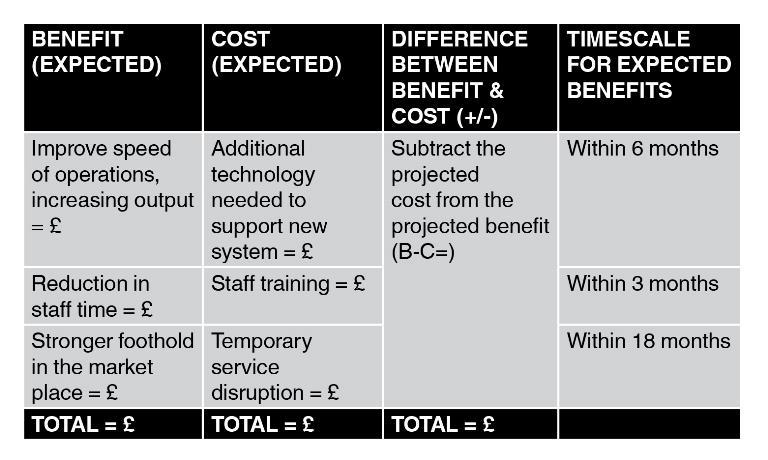
COSTBENEFIT ANALYSIS
• "In the final analysis, you get what you pay for (James Sinegal, CEO Costco)."
• The concept will enable business owners, project leaders and practitioners to grasp the basics of cost-benefit analysis and understand the systematic process for calculating and comparing benefits and costs of a project.
• Cost-Benefit Analysis Definition
• Cost-Benefit analysis is an approach to activity appraisal that involves the estimation of the overall cost and benefits in monetary value terms. The activity could be an impending project or proposed policy. The approach is used to determine whether a particular activity is viable or to evaluate the effects of alternative decisions (Barnett, 1985).
Models - Cost-benefit analysis

• Cost-benefit analysis is a useful tool for measuring the expected benefits against expected costs. It can be used in a variety of different contexts, such as deciding whether to introduce a new product or service, initiate a change, or for determining if project A is more profitable than project B. A simple form of this method uses financial calculations by placing a numerical value on both benefits and costs. Cost-benefit analysis can also measure intangible costs and benefits such as environmental and social, although these will inevitably be subjective totals.
• Displayed is a cost-benefit analysis form using an example proposal as its context: “to make substantial improvements to an existing computerised system at a manufacturing plant”.
Initiation stage aims to evaluate a vague project proposal vision for organizational improvement.
Innovation Project
Initiation
Translation from business vision to a project definition involves a complex communication process.
Steps in initiation: Translate vision into definitional point for management assessment.
Charter signed by management sponsor officially recognizes project moving forward.
Goal: Develop approaches involving stakeholders interested in the project.

Innovation Project Initiation
Project initiation involves improving current processes, growing or transforming the business.
Management considerations for project approval: alignment with goals, duration, cost, resource requirement.
Steps in the project approval process include the project vision, business case, organizational and management review, and charter signing.
Business Case-Documentation of the Vision:
Innovation Project
Initiation
Business Case is crucial in translating the project vision into tangible and intangible value.
It provides financial estimates, risk assessment, and goal justification for resource expenditure.
Major sections of the Business Case include project objective, problem/opportunity statement, solution strategy, goal fit, assumptions, competitive analysis, benefits, cost estimates, recommendation.
Audience for the Business Case varies based on the proposal's origin and scope.
Innovation Project
Initiation
Organizational Review involves varying levels of review based on project size and impact. Management Review follows the Business Case and internal review, seeking formal approval to move forward. The Charter is a key document signifying formal approval and authorizing the existence of the project.
The Charter contains project objectives, requirements, boundaries, deliverables, milestone schedule, resource authority, constraints, management review steps, key stakeholders, project manager's name.
The Charter helps focus resource expenditures on projects aligned with organizational goals.
Developing a Business Case
Introduction
The introduction of new initiatives is vital if companies are to enhance business performance and evolve in an ever-changing business market. Typically, an organisation will have to make a choice between several business ideas, only a small proportion of which it will be able to fund in any one financial year. A business case presents the potential benefits of proposals to introduce a new product, service, or process, or indeed to amend existing ones.
A business case provides the evidence needed to support a proposal, justifying the initial and long-term investment of the personnel, time, funds and resources required to carry it out, measured against the projected long-term business benefits. It enables senior managers to assess the potential value of competing proposals and to make sound judgements about the most profitable business ideas and to make optimal decisions about where to invest efforts and resources.
Business change activity often takes the form of a project of some kind and it is common practice across many sectors and industries for the production of a business case to be part of the project initiation process.
Developing a Business Case Definition

• A business case is a detailed recommendation for making a business change of some kind, whether it is the introduction of a new product or service or amendments to processes and procedures.
• The business case estimates the resources required and the costs involved in implementing and maintaining the proposed change and assesses the potential risks and benefits to the business.
• A business case is usually set out in a formal document, but may also be presented in a visual format, video or PowerPoint, for example.
Developing a Business Case
• A business case is often presented as a written document, followed by an oral presentation. A written business case will typically include the following elements:
• Introduction - the purpose of the proposal and the reasons forundertaking the change proposed
• Business objectives - how the activity will help to meet wider organisationalobjectives and fit in with existing strategy
• Customer needs and wishes - what currently unserved customerneed the initiative will fulfil and what evidence there is of customers' needs
• Options considered and solutions recommended - thepros and cons of alternative scenarios and proposals
• Project scope - the parameters ofthe project
• Assumptions - this could include factors such as estimates of the economic life ofthe product, predictions of demand, development schedule, etc.
• Costing, benefits, and financial implications (see point 2 below)
• Investment appraisal - a comparison of the costs of developing, operating and maintaining the project measured against the benefits and savings expected from its introduction
• Proposed timescale – the length of time required to implementthe activity. A business case will normally cover three to five years
• Risk and mitigation - the possible risks of implementing the project with counterbalancing solutions
• Communications strategy - how communication with key stakeholders will be maintained throughout the project life cycle
• Achievability - an assessmentof whetherthe organisation is currently in a position to deliver the new product or service or whetherthere is a need to invest in new systems or infrastructure to make the new product or service viable.
Developing a Business Case
This list is by no means exhaustive, but includes the characteristic elements of a standard business case. Additional information could also include details of any market research used to support the proposal, gaps in the market, success criteria, project sponsor, technical requirements, and roles and responsibilities of key stakeholders.
Before deciding which elements to include in the business case, you need to ascertain whether your organisation has an standard format for project proposals or business cases. If so, make sure that you follow any existing guidelines and requirements. It is also essential to find what criteria the business case will be judged against.

Developing a Business Case –Costings
In all likelihood, your proposal will be competing with others to gain approval. Therefore senior managers will be examining its value and practicality, and assessing whether it is a profitable way of spending the organisation's budget. In order to give your proposal the best possible chance of success, you must show that the return on investment justifies the initial outlay and maintenance costs required to put the idea into action. Your proposal will be scrutinised by many different parties, so make sure your evidence is watertight. The case should be made either in terms of added value, i.e. the income generated will exceed the cost of implementation, or on the basis of the return on investment, i.e. the cost of the investment is justified by the financial returns it affords. Additional financial elements to consider in your proposal are:
Business benefits and savings - an estimate of the monetary or strategic value of the benefits and/or savings to be gained. Make an estimate based upon the knowledge you have of the anticipated end-users of the product or service. Where possible, state the benefits and savings in measurable terms, avoiding vague statements such as 'better', 'cheaper' or 'faster'
Costs - a calculation of the development costs of the proposed idea and the time frame over which these costs will be accrued
Operational cost - a calculation of yearly operating and maintenance costs , e.g. operational staff, equipment use, raw materials
Discounted cash flow - inflation will affect the value of a product over time. Therefore, if you are proposing the introduction of a product, you will need to apply a discount factor to calculate its value in, for example, five years' time. Our related checklist on Discounted Cash Flow gives more information on this topic.

Developing a Business Case- Benefits
Focus on the business benefits of your proposal rather than on the costs involved in its implementation and maintenance. In particular, stress the financial benefits so that stakeholders can compare these with the initial cost of implementing the scheme. Emphasise the predicted advantages for both the wider organisation and for the individuals to whom the case is being presented.
Your audience will want to see hard financial benefits, so try to provide solid evidence wherever possible to give your case the best possible chance of acceptance. However, bear in mind that softer benefits such as customer satisfaction; savings in staff time and resources, gaining a competitive advantage, enhancing business reputation, and generating innovation will add to the desirability of your proposal.
Developing a Business CaseSupporting Evidence
To present your proposal as a viable and realistic investment, show that you have made realistic projections of the return on investment, and have taken into account all the costs involved in its execution.
Estimate future income using supporting evidence such as a like-for-like comparison, or the results of a pilot scheme that shows that the innovation has already worked well within the organisation and represents 'good practice'. Put details of this evidence into appendices.
Don't ignore or attempt to hide any risks or disadvantages inherent in your proposal but present courses of action which can be undertaken to minimise the risks and counterbalance any problem areas.
Demonstrate that you have taken account of the inherent risks involved as well as the advantages - this will show that you have taken a balanced approach and have considered all aspects of the proposal and provide the reassurances that decisions makers are looking for.
Developing a Business Case Gaining Support
Gaining the support of senior managers is crucial for the success of your proposal. Such backing is necessary to obtain the funding and resources required for implementation. The importance of this cannot be underestimated - if key stakeholders do not feel included or involved in shaping the proposal, you may not be able to rely on their support later on.
It can often be worthwhile to elicit the support of individual senior managers before presenting the final business case. This will enable you to address any objections or concerns they may have in advance and to assess how likely you are to gain approval for your proposal. Whether this approach can be adopted will depend to some extent on organisational practice and culture. However, once you have gained the initial interest of senior managers, you will be in a stronger position to present your case to key stakeholders and those who will be involved executing it.
Developing a Business Case Present Your Case
Once you have written and circulated a business case in written form, the next stage may be to make an oral presentation to stakeholders and interested parties in order to 'sell' your idea. In order to convince others to invest in your proposal, you must demonstrate that you believe wholeheartedly in your endeavour and its success. Consider how best to present your case in order to optimise its impact.


To make certain that the presentation is pitched at the right level and is communicated successfully using appropriate language, you firstly need to gain an understanding of who your audience are. The support of the audience will be critical for success so try to anticipate their reaction as far as possible. The business case can be presented in a number of ways depending on the audience and the culture of the organisation.


Take the content of the case into account as well. For example:
Developing a Business Case Present Your Case
If it is a complex proposal, accompanying literature may be deemed appropriate to aid comprehension but do not just print out handouts of your presentation
If you are using presentation software such as PowerPoint or Prezi, for example, be sure to use it effectively to highlight key points, rather than reproduce in detail what you are saying
Visual aids, such as a flipchart, can be used to accentuate key elements but be careful not to use them too heavily or they may lose their impact.
You need to capture the audience's attention from the outset, so think carefully about how to open your presentation. Begin by outlining your proposal, its benefits and costs, and communicate how the case will be developed. The case should be concise and well argued, taking no more than five minutes to present.
Developing a Business Case Present Your Case
You can't assume that your audience have read your original report so avoid frequent references to it. It is also essential to consider how to close your presentation.
An effective summing up brings all the key points of your proposal together in a concise manner. You should make it plain what feedback or input you are looking for from others, so that your audience is left in no doubt as the next steps - what they need to do and what level of involvement is required. For further guidance on making presentations see our related checklists under Additional Resources.
Developing a Business Case Rehearse Your Case
As with any endeavour, practice makes perfect. Time yourself, analyse your presentation and try to see it from your audience's perspective. What objections might be raised? Are there any evident 'gaps' in your business case? As with an interview scenario try to anticipate questions you may be asked, typically the what, why, how, who, and when. For example:
What will it cost?
Why should current practice be changed?
How will it help our customers?
How is the change to be made?
Who will be involved in its implementation?
When should it be completed?
Your case needs to be polished, professional and to the point. Most importantly, ensure that you have checked all the facts that support your proposal, especially the financial projections. Consider committing key figures to memory so that questions can be answered quickly and effectively without having to search through your documentation.

Developing a Business Case Be Prepared for Objections
Although thorough preparation will reduce the number of objections, it will not eliminate them entirely. Sensitive issues such as risk, costs, resources and time will inevitably invite challenge. Remember too, that different members of your audience will have different objectives depending upon their position and function within the organisation. So be ready for questions and prepared to handle challenges to various facets of your proposal.
Developing a Business Case- Offer Alternatives
One method of dealing with objections is to offer alternative scenarios. For example, if there is an objection to one aspect of the proposal, put forward a different viewpoint so that the benefits afforded by your proposal are highlighted from a fresh angle. Offering a choice will give your audience a sense that they are in control and are in a position to be involved in shaping the proposal, rather than being forced to accept something which is already set in stone. Providing several different options for your audience to consider means that they have alternatives to consider and reduces the likelihood that they will dismiss your idea out of hand without giving it due care and attention. However, you still need to be clear why you made your initial recommendations - state your case with confidence, and answer objections by demonstrating the benefits.
Developing a Business Case- Maintain Communication
Once your project has been approved, it is important to monitor and communicate its progress to interested parties on a regular basis. Develop a communications strategy to achieve this objective. Keep track of the proposed timescales presented in the business case to ensure that the project does not run over time. The business case should be used to keep the project on track, so maintain momentum by continually reviewing the progress and status of the project.

Business Case- Document outline

• Introduction
• This document outline provides guidelines on the typical contents that should be included in a business case. Business cases are prepared for a whole host of different investments in a variety of industries and markets. This document covers the standard contents that should be included in a business case concerned with investments in new or improved products, services or processes.
• Typical contents
• Introduction
• Business objectives
• Strategic fit
• High level business and technical requirements
• Options considered and recommended solution
• Scope
• Business benefits
• Assumptions
• Constraints
• Costs and budgets
• Proposed timescales
• Risk management
• Investment appraisal

Business Case- Document outline

• Detailto be included in each section
• Introduction
• The introduction should describe the purpose of the document and the background to the business case – what business conditions have triggered the need forthe business case and the current position of the business.
• Business objectives
• This section should define the business objectives, (e.g. expand market share through new channels, eliminate waste in processes) thatare required by the business case – such objectives should be SMART. Included in this section should be the critical success factors and how they are to be measured
Business Case- Document outline
• Detail to be included in each section
• Strategic fit
• Here the link between the business case and the strategic objectives of the organisation must be spelt out. Most strategic objectives come down to two main aims - increase revenue and reduce costs for commercial organisations, and improve customer service levels and reduce costs for government and noncommercial organisations. Therefore the business case must show how it contributes to the strategic objectives of the organisation.
Business Case- Document outline
• Detail to be included in each section
• High level business and technical requirements
• Here the business requirements and any technical requirements, (if it is an IT related investment or a new facility or product investment) should be highlighted.
• The business and technical requirements should be expressed as outcomes.
• For example, if the business case is for a new call centre with appropriate technology to ensure faster customer service, the business case should identify the number of service seats required, the type of information to be fielded by the call centre, the skills and abilities required by the staff, the response times to be provided for customers and the technology architecture required to meet organisational standards

Detail to be included in each section
Business CaseDocument outline
Options considered and recommended solution
This section should outline the options that have been considered with a SWOT analysis relating to the critical success factors highlighted in the Business objectives section. Included in the options should be a consideration of the costs and benefits of each option, the risks associated with each option and alternative delivery methods for the various options. The options should be ranked by a set of predetermined criteria against which a recommendation should be made.
Business CaseDocument outline
DETAIL TO BE INCLUDED IN EACH SECTION
SCOPE THESCOPE OF THEPROJECT AROUND WHICH THEBUSINESS CASE IS BUILT SHOULD BE SUMMARISED WITH AVIEW TAKEN OF THE RANGE OF SCOPE (MINIMUM TO MAXIMUM) POSSIBLE AND HOW IT WILL SATISFY THE BUSINESS NEED.
THEAREAS THAT ARE OUT OF SCOPESHOULD ALSO BE HIGHLIGHTED. FOR INSTANCE, IN THECASEOF A PROJECT DESIGNED TO HANDLE LEGISLATIVE CHANGES THAT IMPACT MOST BUT NOT ALL
Detail to be included in each section
Business CaseDocument outline
Business benefits
The range of benefits that will be derived from implementing the project should be highlighted.
Benefit areas include:
• Financial benefits such as increased revenue, reduced cost, regulatory benefits such as compliance with legislation, environmental factors
• Operational benefits such as improved process efficiencies, better data quality
• Soft benefits such as improved working conditions for staff, increased customer satisfaction levels.
Business Case- Document outline
Detail to be included in each section
Assumptions
The assumptions used in the preparation of the business case need to be recorded.Assumptions around costs, benefit calculations and resource availability should be included in this section.
Constraints
The main constraints to be taken into account regarding the achievability of the project should be summarised- such as the willingness of senior management to absorb fundamental business change, the affordability of the proposals, existing contractual commitments that may impinge on the ability to implement some of the business case proposals.
• Detail to be included in each section
Business CaseDocument outline
• Costs and budgets
• Estimates of the whole lifetime costs of the project should be included highlighting the schedule of costs over the project period. The costs should, as a minimum, be categorised into capital and revenue costs. There should be a clear indication of the intended sourcing for each budget category, i.e. which part of the organisation is funding the cost elements.
• Proposed timescales
• The proposed timescales should be included, showing any project phasing and the main milestones in each phase, together with the main points at which approval is required to progress from one phase to the next. Any major dependencies should be highlighted, (e.g. interfaces with other projects).
• Detail to be included in each section
Business
CaseDocument outline
Risk management
The main risks relating to the proposals should be identified with some analysis of the probability of each risk occurring and the impact should it occur. At this stage an outline plan for how the risks are to be mitigated should be included.
Investment appraisal
This section should show (preferably by means of a graph or similar visual aid) a year on year payback profile, with costs and benefits and the point at which payback will occur

Business Case- Document outline
• Detail to be included in each section
Outputs and outcomes
The output from this process, is a business case document. It is expected that the business case will then go through an approval process specific to the organisation and will be rejected, approved, or approved subject to agreed modifications. The outcome following approval is dependent upon the specific organisational processes but is likely to be followed by the production of a business plan.

Pilot Testing and Prototyping
• -To test the innovation in a controlled setting, ensuring functionality, appeal, and effectiveness before large-scale deployment.
• -This stage allows teams to gather early user feedback and make adjustments as necessary.
• Steps Involved:
• Creating a Limited Version or Prototype: This could involve a beta version of a software application, a test batch of a physical product, or a small-scale trial of a service.
• Collecting Initial Feedback: Conducting surveys, interviews, or focus groups with test users to understand their experience with the prototype.
• Troubleshooting and Refinement: Identifying and resolving issues based on user feedback, which could involve adjusting design features, improving usability, or rethinking functionality.

Implementation and Full Deployment
• -To bring the completed innovation to market or introduce it fully within the organization.
• -This phase is where the innovation moves from concept to reality, reaching the intended users or stakeholders.
• Activities Involved
• Launching the Product or Service- Officially releasing the innovation for consumer or employee use, including full-scale manufacturing, marketing, or rollout.
• Rolling Out a New Process- If the innovation is internal, it could involve training employees and integrating the new process into daily operations.
• Stakeholder Engagement- Engaging with employees, customers, and partners to ensure a smooth transition, gain support, and address any initial challenges.
STAKEHOLDER ANALYSIS AND MANAGEMENT
• "Essentially, a good understanding of stakeholder management enables a firm to compete effectively by building and prioritising key relationships (Co and Barro, 2009; Friedman and Miles, 2002)."
• The purpose of the concept is to explore the ideas and experiences in developing and applying stakeholder analysis. The concept sets out the benefits of stakeholder analysis and provides indicative guidelines and recommendations for its implementation.
Stakeholder Analysis and Management Definition
• Stakeholder analysis refers to the methodological process of identifying the different types of individuals and groups who have an interest in or impact on an organisation. Stakeholder management is the processes and strategies deployed by the organisation to manage stakeholder expectations and power levels, as well as conflicts of interest (Co and Barro, 2009; Lynch, 2006).
Communication
Communications Management involves processes for the generation, collection, distribution, storage, retrieval, and disposition of project information.
PMBOK Guide outlines three basic communications processes:
• Plan Communications Management
• Manage Communications,
• Monitor Communications.
Plan Communications is crucial, aiming to identify stakeholder communication needs, timing, content, and preferred media. It results in a communications management plan.
Communication
• Various formal communication methods include periodic reports, meetings, presentations, and logs, each tailored to specific stakeholder groups and needs.
• The planning process involves defining recipients, responsible team members, output content, storage location, delivery timing, media, and communication focus.
• Informal communications are dynamic and less planned, fostering open exchanges of ideas between parties.
• Communication targets include internal team members, management stakeholders, and external audiences, each with unique information interest needs.
Communication
• A communication matrix helps manage formal documents, and key milestones or checkpoints may require additional reporting.
• Information distribution involves moving needed information to stakeholders, considering methods, technology, and intragroup sharing.
• Reporting project performance includes aspects like time and schedule variance, work performance status, quality-related data, and ethical reporting is essential.
• The human communications model involves sender, receiver, transmission media, encoding, message, noise, and decoding, emphasizing the importance of understanding in communication.
Communication
• Effective communication ensures agreement and useful action, preventing conflicts and promoting team engagement.
• Communication channels include upward, downward, and lateral communication, and the number of channels increases with the project stakeholder population.
• Causes of communication breakdown include common language issues, communication mechanics, personal factors, communication style, and workplace factors.
• Project status information is communicated using tools and terms like WBS, Gantt, and Earned Value, emphasizing the need for effective communication skills.

Communication

Project managers play a crucial role in improving communication effectiveness, requiring an understanding of its importance in project success.
Effective listening is a key attribute of a good communicator, involving techniques like asking questions, paraphrasing, reviewing understanding, asking for examples, ascertaining feelings, showing interest, and using nonverbal techniques.
Communication Matrix Communication
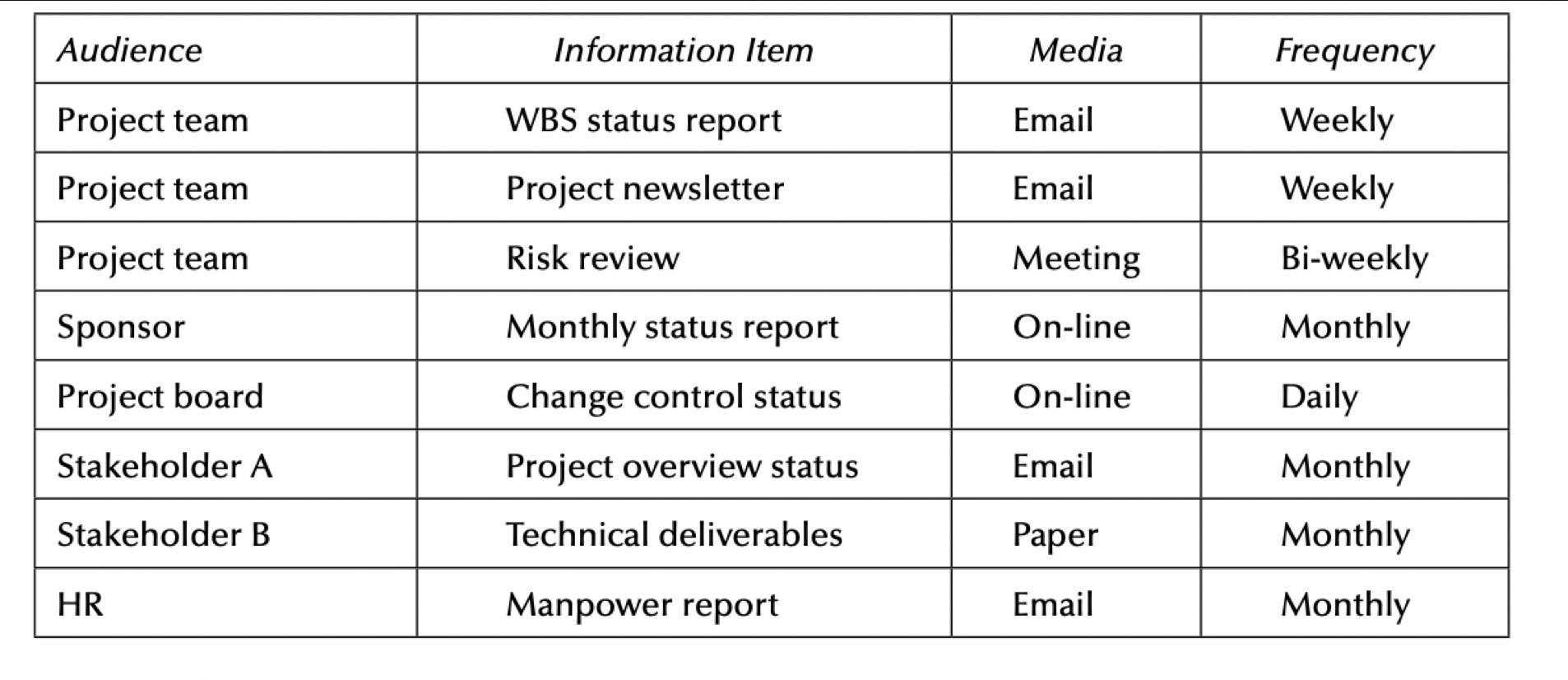
Feedback and Continuous Monitoring
To track the performance and impact of the innovation once deployed. This phase focuses on ongoing evaluation and improvement, ensuring that the innovation meets objectives and delivers the intended value over time.
-Collecting User Feedback: Directly gathering opinions, reviews, and complaints from users through surveys, feedback forms, and social media channels. This feedback offers insights into how well the innovation is meeting user needs and areas where adjustments are needed.
-Monitoring Key Performance Indicators (KPIs): Tracking metrics that measure the success of the innovation, such as user engagement, customer satisfaction, revenue growth, or operational efficiency. These KPIs help quantify the innovation's impact and ensure it aligns with organizational goals.
-Addressing Emerging Issues: Identifying and resolving issues as they arise, ensuring the innovation remains functional and effective. This may include software patches, product adjustments, or customer service enhancements.
"KPIs should: (1) tell a story; (2) represent a reduction or construction of reality; (3) act as a base to spin a story around; (4) vary between organisations (Catasus et al., 2008)."
Key Performance
Indicators
Too often organisations combine other performance measures with that of KPIs, which can lead to difficulties in managing performance and tracking success. Practical implementation steps and case evidence provided helps leaders to focus on quality KPI’s that directly measure the areas needed in order to achieve success.
Key Performance Indicators Definition
• Key performance indicators (KPIs) are agreed upon performance metrics designed to give managers and employees oversight of whether people are on track to meet targets and goals. In addition to end goals and results, KPIs provide a tool for defining what success looks like over an extended period of time. Multiple KPIs are often deployed simultaneously to provide a rounded picture of performance at individual and team levels (Ax et al., 2009; Kennerey & Neely, 2003).
Key Performance Indicators
Key Performance Indicators (KPIs) are quantifiable metrics used to measure the success or performance of a project or organization.
Types of KPIs:
-Project Management KPIs:
• Schedule adherence
• budget variance
• quality metrics.

Key Performance Indicators
Business KPIs
• Revenue growth
• Customer satisfaction
• Market share.
Example KPIs-
• Percentage of tasks completed on time
• Cost variance
• Customer satisfaction score.

Key Performance Indicators
Definition
Options appraisal is a structured process for evaluating different options or alternatives based on predefined criteria.
Methods:
1. Multi-Criteria Decision Analysis (MCDA):
• Assigns weights to different criteria and scores each option against these criteria.
2. Cost-Effectiveness Analysis (CEA):
• Compares the costs and outcomes of different options to determine the most cost-effective one.
Key Performance Indicators
Example Application
Conducting an options appraisal to choose between different project delivery methods (e.g., design-bid-build vs. design-build) based on criteria such as cost, time, and quality.
Advantage:
• Provides a systematic framework for decisionmaking
• Allows for comparison of multiple options against specific criteria
• Helps in identifying the most suitable option
Review and Evaluation
To conduct a comprehensive assessment of the innovation's impact, drawing conclusions on its effectiveness and extracting lessons to guide future innovation projects. This final evaluation helps organizations refine their innovation processes and improve strategic decision-making for subsequent initiatives.
Steps Involved-
Reviewing Achievements- Summarizing the innovation’s accomplishments, such as reaching target markets, meeting user expectations, or achieving operational improvements. This review helps celebrate successes and highlights effective strategies.
Evaluating Financial Returns- Examining financial metrics, including return on investment (ROI), cost savings, or increased revenue. This financial analysis helps determine if the innovation has contributed positively to the organization’s financial health.
Assessing Stakeholder Satisfaction- Gathering input from stakeholders (employees, partners, customers) on their experiences and satisfaction with the innovation. This feedback can reveal areas of success as well as any unmet needs or dissatisfaction.
Identifying Lessons Learned- Reflecting on the challenges, successes, and areas for improvement experienced during the innovation project. These insights can guide the development and implementation of future innovations, enhancing overall effectiveness.

Stakeholders – Eden & Ackermann
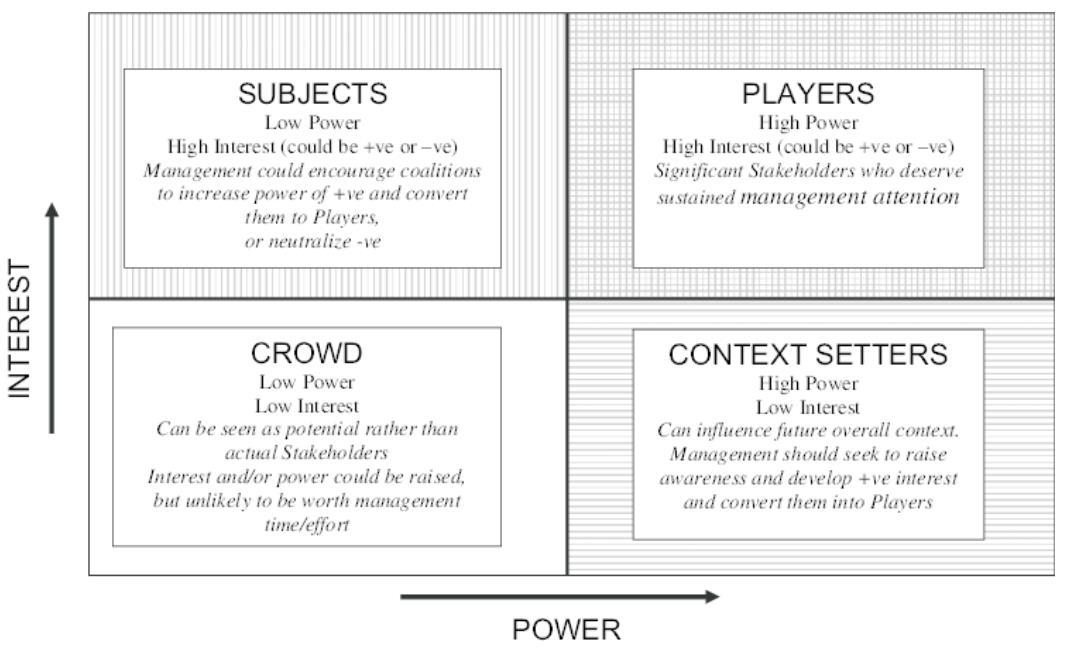
A stakeholder is a party that has an interest in a company and can either affect or be affected by the business. They are users, governance, influencers and providers.
C. Eden and F. Ackermann in Strategic Management of Stakeholders 1998 theory outlined main principles identify and manage those. In summary these are:
• Identifying who the stakeholders really are in the specific situation
• Exploring the impact of stakeholder dynamics; acknowledging the multiple and interdependent interactions between stakeholders
• Developing stakeholder management strategies; determined through stakeholder’s power to, and interest in, influence the organisation’s direction
Understanding the Manager's Role in Driving Innovation
-Managers play a central role in leading innovation efforts, guiding the process from idea generation through implementation and evaluation.
-Responsibilities involve championing ideas, securing resources, managing stakeholders, and maintaining open communication to ensure the successful adoption of innovative initiatives.
-Effective innovation management requires strategic thinking, adaptability, and collaboration.

1. Championing Ideas
-Managers who champion innovation serve as advocates for new ideas within an organization.
-Bridge between creative concepts and their realization, providing support, resources, and encouragement to help these ideas flourish.
-Lead by example, fostering a culture that values and rewards creativity and calculated risk-taking.
Responsibilty:
- Inspire team members to think creatively and bring new ideas forward by creating a supportive environment.
-Advocate for risk-taking, emphasizing the importance of learning from failures as much as from successes.
- By promoting novel ideas to other leaders and stakeholders, managers play an essential role in transforming these ideas into actionable projects.
2. Gaining Stakeholder Buy-in
and
Commitment
To successfully implement an innovation, a manager must gain buy-in from key stakeholders.
These stakeholders, whether internal (employees, leadership) or external (clients, partners), provide critical support that ensures the project is adequately funded, aligned with strategic goals, and accepted across the organization.
-Recognizing individuals or groups whose support will be essential, including those affected by the change or responsible for implementing it.
-Demonstrating how the innovation aligns with stakeholders’ needs and interests, making the value of the innovation clear to all involved parties.
-Proactively address concerns or objections, creating an open dialogue that builds trust and commitment to the project.
2.Gaining Stakeholder Buy-in and Commitment
KAI Theory Link
Recognises that individuals have different cognitive styles—some are more adaptive, preferring incremental changes, while others are innovative and favor radical change.
Managers must identify whether stakeholders lean towards adaptation or innovation to tailor their communication and engagement strategies effectively.
Adaptors: Prefer stability and gradual improvements. Managers might emphasize reliability, efficiency gains, and minimized disruptions.
Innovators: Open to radical change and new challenges. Managers can focus on the groundbreaking aspects of the innovation and its potential for significant transformation.
2.Gaining Stakeholder Buy-in and Commitment
Activities Involved
-Setting up sessions to communicate the vision, goals, and benefits of the innovation.
-Using KAI-informed strategies to appeal to different cognitive styles, from adaptors to innovators.
-Continuous engagement to keep stakeholders informed and address new concerns.
3. Managing Stakeholders
Effective innovation depends on the support and involvement of various stakeholders, each bringing unique perspectives and resources. Managing stakeholders involves understanding their expectations, addressing concerns, and clarifying roles to ensure that all involved parties contribute meaningfully to the innovation process.
-Using frameworks such as the RACI Matrix (Responsible, Accountable, Consulted, and Informed) to clarify the role of each stakeholder in the innovation project.
-Ensuring all stakeholder views are considered and aligned with the project’s objectives.
-Regular updates and transparent decision-making processes maintain stakeholder engagement and support.
Innovation projects often require additional resources, such as financial backing, human expertise, and technology.
Managers are responsible for identifying these needs, securing necessary resources, and allocating them efficiently across the project.
4. Securing Resources
-Assessing project requirements and outlining essential resources.
-Presenting a business case to senior management or investors to obtain financial backing.
-Strategically distributing resources to ensure smooth project progress and maximum impact.
5. Research and Investigation

Managers must conduct thorough research to validate the potential of an innovation. This involves understanding market demands, identifying competitor activities, and exploring new technologies or processes. Comprehensive research provides datadriven insights that guide innovation decisions.
-Assessing whether the innovation aligns with the organization’s resources and capabilities.
-Identifying target audience needs and preferences.
-Analyzing potential challenges and roadblocks.
Activities Involved
-Bringing in consultants or specialists for insights on trends and technologies.
-Using quantitative data to gauge potential success and evaluate risks.
-Surveys, focus groups, and industry reports provide insights into customer needs.
6. Establishing Processes and Procedures
Innovation management benefits from structured processes that allow for consistent development, prototyping, implementation, and evaluation. Managers establish these processes to ensure that projects stay on track and meet organizational standards.
-Creating timelines, milestones, and protocols that guide each phase of the innovation.
-Ensuring that resources are used effectively to prevent delays and budget overruns.
-Establishing checkpoints to hold team members responsible for progress and quality.

7. Communication
-Clear and consistent communication is the backbone of successful innovation. Managers are responsible for keeping all stakeholders—team members, leadership, and external partners—informed about the project's progress, goals, and any adjustments.
- Effective communication ensures alignment, reduces misunderstandings, and builds trust within the innovation team.
Key Components
• Regular Updates
• Feedback Loops
• Open Forums for Discussion

8. Supporting and Implementing Good Practice
Managers play a crucial role in establishing and maintaining best practices within the innovation process. By promoting a culture that values ethical standards, continuous learning, and transparency, managers help create an environment where innovation can thrive sustainably.
Activities Involved
• Learning from Failures
• Fostering Transparency
• Reinforcing Ethical Standards
9. Monitoring and Measuring Impact
To assess the success of innovation initiatives, managers need to monitor key performance indicators (KPIs) and gather both quantitative and qualitative feedback. Measuring impact not only demonstrates the innovation’s effectiveness but also provides insights for future improvements.
Activities Involved
• Tracking KPIs
• Gathering Feedback
• Adjusting Strategies
Stakeholders in the Innovation Process
-Stakeholders can influence innovation through idea generation, decision-making, providing approval, consulting during the process, testing outcomes, and giving feedback.
-Bring diverse perspectives and expertise, which can shape the direction and success of innovation initiatives.
Stakeholders in the Innovation Process
a) Idea Generation
-Stakeholders often play a role in the initial ideation phase by contributing insights or identifying unmet needs.
-Employees, customers, or suppliers can be invaluable sources of innovative ideas, providing perspectives that align with real-world requirements and market demands.
-Organizing brainstorming sessions or surveys with key stakeholders to gather initial ideas for product or process improvements.
Stakeholders in the Innovation Process
b) Decision-Making and Approval
-Stakeholders involved in decision-making determine the feasibility and strategic alignment of innovation initiatives.
-Senior leaders or boards often hold the authority to approve or reject ideas based on the organization’s goals and available resources.
Ex: Managers may present a business case for an innovation project to senior leadership for budget and resource approval.
Stakeholders in the Innovation Process
c) Consultation and Specialist Advice
-Engaging experts or consulting stakeholders at various innovation stages can ensure that technical, legal, or operational concerns are addressed early.
-Specialists provide targeted insights that can enhance the quality and viability of the innovation.
d) Testing and Feedback
-Stakeholders involved in testing play a key role in validating the innovation.
-Customers or employees may test prototypes and offer valuable feedback, allowing the organization to refine the product or process before a full rollout.
2. The RACI Matrix in Innovation
Stakeholders in the Innovation Process
The RACI Matrix is a tool that helps clarify each stakeholder’s role and responsibility in the innovation process.
By categorizing stakeholders as Responsible, Accountable, Consulted, or Informed, managers can define clear expectations and streamline decisionmaking.
Stakeholders in the Innovation Process
RACI Roles
Responsible (R)- The person or team responsible for executing specific tasks within the innovation process, such as a product manager overseeing prototype development.
Accountable (A)- The individual ultimately accountable for the innovation’s success, often a senior leader or project sponsor.
Consulted (C)- Experts or stakeholders whose input is essential for making informed decisions, such as a legal team for compliance or IT support for technical requirements.
Informed (I):- Stakeholders who need to be kept updated on progress but are not directly involved, such as employees impacted by the change.
Stakeholders in the Innovation Process
Stakeholder Management Strategies
-Requires balancing competing interests and maintaining engagement throughout the innovation process.
Key strategies include:
1. Regular Communication-Keeping stakeholders informed fosters transparency and builds trust.
2. Alignment with Goals- Ensuring that stakeholders understand the alignment of the innovation with organizational goals can increase support and reduce resistance.
3. Feedback Mechanisms- Incorporating feedback from stakeholders not only improves the innovation but also makes stakeholders feel valued, increasing their commitment to the initiative.
Identify

Ensure
Identify all the stakeholders at the beginning of the project to avoid problem of more stakeholders with disruptive agendas joining after the project starts
Ensure all the stakeholders agree on the project’s deliverables and what their roles are.
Get
8 Tips to Effectively Manage Stakeholders
Practice
Get consensus on how to handle changes to the project.
Practice good communication. The key to engagement is that the communication should be meaningful to all stakeholders.
Keep
Engage
Keep the project vision visible, so everyone to stay focused on what's important.
Engage stakeholders throughout the process in problem-solving, reviewing new requirements, and creating lists of lessons learned.
Agree on Agree on what "done" means and is.
Empathise Empathise with other stakeholders.
Assessing Innovation Outcomes:
Techniques for Measuring Impact

Measuring the impact of innovation is critical for understanding its effectiveness and value to the organization.
-Allows managers to assess the return on investment (ROI), operational improvements, and customer response to innovations.
-Managers can make informed decisions about future innovations, resource allocation, and potential areas for improvement.
Assessing Innovation Outcomes: Techniques for Measuring Impact
1.
Key Performance
Indicators
(KPIs)
KPIs are specific metrics aligned with an organization’s goals, used to evaluate innovation outcomes.
Provide a measurable value that demonstrates the success of an innovation initiative.
Innovation-Related KPIs:
Product Success Rate: Measures the percentage of new products that meet their performance goals.
Cycle Time to Market: Tracks the time it takes for an innovation to go from concept to market, indicating process efficiency.
Customer Satisfaction Score (CSS): Measures customer satisfaction with the new product or service, providing insight into market acceptance.

2.Financial Measures
Assessing Innovation Outcomes: Techniques for Measuring Impact
Financial measures are widely used to assess the economic impact of innovation.
Provide a clear view of how innovation contributes to the organization’s profitability and cost structure.
a) Revenue Growth
Revenue growth from new products, services, or processes can indicate the financial success of an innovation.
This metric can be used to compare revenue from preinnovation periods to post-innovation periods.
Assessing Innovation Outcomes: Techniques for Measuring Impact
2.Financial Measures
b) Profit and Cost Reduction
Profit is a direct indicator of financial performance, while cost reduction from process improvements reflects the efficiency gains achieved through innovation.
Assessing Innovation Outcomes: Techniques for Measuring Impact
3. Customer Acquisition, Loyalty, and Retention
-Understanding how innovation impacts the organization’s market position and brand loyalty.
a) Customer Acquisition Innovation can attract new customers by meeting unmet needs or offering unique value propositions. Measuring the number of new customers following an innovation provides insight into market penetration.
b) Customer Loyalty and Retention
Loyalty metrics, such as repeat purchase rates or customer lifetime value (CLV), can reflect how well an innovation meets customer needs over time.

4. Market Share and Reach
-Measures an organization’s portion of the market that it occupies, while market reach considers the geographical or demographic range.
-Reflect competitive advantage and brand visibility gained through innovation.

5. Compliance and Quality Audits
Assessing Innovation Outcomes: Techniques for Measuring Impact
-For organizations in regulated industries, compliance with standards and quality assurance are critical aspects of innovation impact measurement.
-Quality audits can ensure that new products meet safety, quality, and regulatory standards.

6. Customer Feedback, Ratings, and Reviews
Assessing Innovation Outcomes: Techniques for Measuring Impact
-Provides direct insight into how well an innovation is received and whether it meets customer expectations.
-Metrics based on feedback can include average star ratings, survey responses, and reviews, which help refine future innovation strategies.

Assessing Innovation Outcomes: Techniques for Measuring Impact
7. Balanced Scorecard (BSC) Approach
The Balanced Scorecard is a comprehensive framework that includes financial and nonfinancial measures, providing a holistic view of innovation performance across four perspectives: financial, customer, internal processes, and learning and growth.
Assessing Innovation Outcomes: Techniques for Measuring Impact

BSC for Innovation
• Financial Perspective-Measures revenue, cost savings, and ROI.
• Customer Perspective- Evaluates satisfaction, acquisition, and retention related to innovations.
• Internal Process Perspective- Assesses cycle time, quality, and compliance.
• Learning and Growth Perspective- Tracks employee engagement and skills developed through innovation.
Learning Outcomes

Understand the role of innovation within organisations
Understand the process of managing innovation in an organisation
